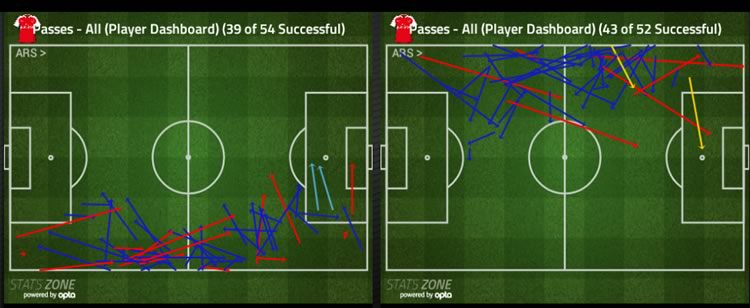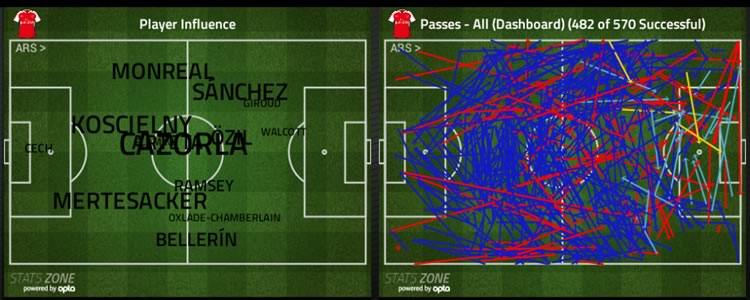While Theo Walcott and Olivier Giroud continue to battle for the centre-forward spot, it was Alexis Sanchez who stole the show. His hat-trick in the 5-2 win over Leicester City was book-ended by goals from Arsenal’s two other striking options – Walcott sliding the ball home to equalise early on and then Giroud adding the fifth late after coming off the bench. But it was Alexis’s return to form that would have most pleased Arsene Wenger because he wants goals from all over and the Chilean is the best at providing that.
In another season, Alexis’s hat-trick might have persuaded Wenger to give him another go up front yet the manager seems convinced of Walcott’s potential as the spearhead in attack. He certainly gave him good reason to as the England man delivered another promising display of intelligent running and constant space-seeking.
Yet, Wenger will also be delighted about how Walcott mixed up his game against such uncompromising opponents, not just as a threat behind but using his body to protect the ball. He was more involved on Saturday, touching the ball 28 times with a 92% pass accuracy. One move that caught the eye was a one-two with Santi Cazorla, flicking the ball to the midfielder with his back to goal before curling the return pass wide of the post. For me, actions such as this will govern how effective he will be at centre-forward because the best small, wiry strikers don’t try and engage defenders in physical duels but instead find clever ways to get a yard of space and then spin away. At the moment, Walcott likes to move wide, especially towards the left-hand channel to gather up speed to get away. Against Leicester City, it worked a treat, especially with Alexis drifting into the middle, though the test will be how he does against stronger defences, who can squeeze the spaces for Arsenal to play.
Olivier Giroud came off the bench to complete the rout and, by scoring as a substitute again, he sort of reaffirms the idea that he’s best towards the end of games where defences are tired and he doesn’t labour as much to find space. Giroud is a fantastic pivot yet his touch has been erratic lately. However, teams evolve and Walcott brings more mobility and variety to Arsenal’s play at the moment.
In the not too distant past, Giroud’s grip on this team has been like a habit; he’s a release when things need to get a little ugly – an out-ball when the opponents make it hard to pass through. Ozil particularly likes to play off him, though at times it’s arguable that Arsenal are too eager to use Giroud, bouncing passes off him instead of holding on to the ball and working it from side to side, waiting for gaps to open. With Walcott, the temptation might still be there to slip him through, especially you see him buzz past your eye-line into space, but the team generally is more inclined to keep the ball and create more danger-zone passes.
The suggestion is that Walcott’s style suits Arsenal in games where the opponents push up – such as this for example – yet defenders hate being turned and facing their own goal and its clear every game, Walcott has them scared. The natural reaction then is for opponents to drop off, but the after-effect of that is it hands Arsenal the midfield. Leicester did that in the second-half and paid the price.
Leicester threaten early on but hand initiative back to The Gunners
Being a defender, it’s natural that you focus on your part of the pitch, but there was more than a hint of truth in when Per Mertesacker said Arsenal “struggled defensively” and “lacked stability but that is normal at Leicester.” The Foxes gave Arsenal a particularly difficult start and could have been 2-0 up, hitting the bar before Arsenal went down the other end of the pitch to equalise. When The Gunners repeated the same trick, this time Alexis getting onto the end of another counter-attack, it was the signal for Claudio Ranieri to change things. At half-time, the Italian boss moved away from the 4-4-2 and to a 4-3-3 to maintain some control in the game. The move proceeded to hand the initiative to Arsenal instead.
It’s hard to say that it was the turning point because Arsenal began to take control of the game around the 30-minute mark. However, before then, Leicester caused them all sorts of problems, particularly on the break when Jamie Vardy ran clear to open the scoring. Those chances were few and far between for the rest of the game until they were forced to open up again towards the end and go back to a 4-4-2.
When Ranieri brought on another midfielder, I tweeted at half-time that it could be the type of move that hands the initiative to Arsenal instead of involving more their best player, Riyad Mahrez. That is to say, Leicester were more effective being direct early on, getting the ball from back to front quickly and turning Arsenal’s midfield (where at that point, I also said Arteta should consider dropping back as a third-centre back seeing as Leicester were keeping two up top all the time).
In the second-half, that threat was more intermittent and while Mahrez got more of the ball, he was more isolated. Perhaps Ranieri changed it because he felt Leicester couldn’t keep the energy up to press for most of the game – indeed, he said as much in his post-match press conference. The stats show how they direct they were, attempting nearly as many final third passes as Arsenal (149-155), and forcing The Gunners to clear more (20-46) by crossing the ball 34 times (to Arsenal’s 11). In the end, if Leicester persisted with the same approach, I’m not saying they would have won the game, but instead of losing 5-2, they might have lost 5-4 instead.
The pleasing return of Arteta
The other turning point was the injury to Mathieu Flamini or, perhaps, the introduction of Mikel Arteta. The Arsenal captain has seen the side evolve in his absence – and the selection of a more aggressive Flamini ahead of him suggested that. However, he showed his worth, coming on to the pitch to bring some calmness to Arsenal’s play, getting his head down and working the ball from side to side. It’ll take a while for him to accrue the defensive stats he did before he got injured and certainly, might have to adjust his game further to become first-choice again. Yet, when he came on, he gave more stability to the side, and particularly on the ball, allowed Cazorla to influence higher up the pitch.
In the main, we saw the two sides of Arsenal’s attack in this game work as one, a wonderfully fluid outfit that could be switched to a rapier-like counter-attack in the blink of an eye. Previously, we would view the two styles as independent; if Arsenal’s wanted to play counter-attack, they would invariably have to drop back into a deep block and then launch men forwards from there. Here, when Arsenal lost the ball, players were in perfect positions to play the ball forward quickly and trade passes off each other. There was no need to drop back if the ball could be won high up the pitch and here Arteta and Cazorla in particular contributed – although the real defensive star was Koscielny, who would frequently step into the midfield and steal the ball off the opponents.
Full-back y’all ever so slightly
The quiet stars of this game were the full-backs, who not only stopped attacks effectively in the face of Leicester’s wing-play, but contributed going forward too. Nacho Monreal ended the game on two assists, while Hector Bellerin should have had one of his own when his cross was deflected ever-so-slightly for Alexis’s first goal. He also had a hand in Arsenal’s third goal, breaking forward early on in the move to add impetus to the attack and ending with Ozil chipping the ball for Alexis to head.
However, what I want to highlight is the differences between the way the two full-backs are involved in the game, which less illustrates the contrasting styles between the two players, but how Arsenal build up on the two sides of the pitch.
The pass charts of Bellerin and Monreal can be shown above. As we can see, Bellerin tends to start wider when he picks up the ball, though quite noticeable are two things: he gives the ball away more, and is forced to go back or long a lot of the times. Monreal, in contrast, picks up the ball narrower in the build-up, and then when he gets higher up the pitch, is a more orthodox, wide influence. He generally gives the ball away with high percentage passes rather than short ones. Both players, though, in terms of pure pass numbers, tend to be just as involved in the game as the other.
The player influence diagram, however, gives us more insight into why the two players pass charts are different – Ramsey tends to be involved more centrally and Alexis wider. When Bellerin gets the ball, he generally has fewer passing options because Ramsey is drawn to the middle. Indeed, that usually means he’s forced to go backwards or is under a lot of pressure when he has possession. By comparison, Monreal has a wealth of options as Ozil and Cazorla are both drawn to that side whilst Alexis always occupies the flank therefore the byline option is always on. Monreal is also clever in that regard because he knows to step inside so that it’s harder to press him. Of course, Alexis’s positioning allows him to do that, as does the confidence of Koscielny to bring the ball out of the defence.
When you get higher up the pitch, both players tend to operate best trading one-twos with their team-mates. Again, Monreal has a number of options he can trade passes with especially with Arsenal tending to overload that side. We can see for final goal the understanding Alexis has with Monreal. The Chilean is aware that the left-back is always going to make a run on the outside and his resulting cross ends up with Giroud with a trademark low finish.
Indeed, his aggressive positioning has been a huge factor in Arsenal going forward and playing well in the last few months. Bellerin, on the other hand, tends to be more isolated thus he uses his burst more frequently, leaving opposition wingers for dead if they don’t track him. His selection of the final ball is getting better as is the partnership with Ramsey even if this game wasn’t really the best advert for it.
The pair did of course combine for Arsenal’s third, a quick give-and-go before Bellerin’s cross. When the ball found its way to Ozil, we saw the other deadly partnership in action, as the playmaker’s cross found the head of the talismanic Alexis. That was his second goal. His third was all about him as he received the ball in the inside left position, deftly knocked the ball past the onrushing defender and then fizzed his shot into the bottom corner.
If this was Arsenal’s best team performance of the season, Arsenal’s best individual performer also stepped up.




